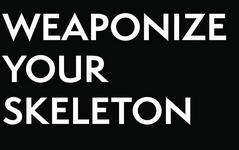Scenario-Based Training vs. The Hard Knot
When people say “scenario-based training”, it’s code for “all the crap that comes before the actual violence”. The yelling, the approach, the grabby man-dance. Of course, once the violence starts it’s all the same old, same old: injury, injury, injury. Pedestrian, predictable, and downright boring. All the stuff that comes before, all the stuff that people are fascinated with, is, for our purposes, a waste of time.
The lead-in to violence for any given scenario is typically antisocial in nature, leading to questions like “How do I deal with his behavior?” and “When do I decide to injure him?” You already have the skills to deal with the former—talk him down, capitulate, or get the hell out of there. As for when to tear into someone, that’s a personal judgment call you have to make in general terms ahead of time; in specific terms it’s based on your read of the situation. If you recognize a threat and you think you can’t live with it, then get busy shutting him off. If you think it’s something you can live with—merely antisocial in nature—then act accordingly. Use your social skills, or set a new 100-meter dash record, or tear into him as you will. In other words, act according to your comfort level.
This threshold will vary from person to person based on life experience. Some people can stomach all kinds of crazy antisocial behavior; others will brook no threat whatsoever. Either way, it’s a personal judgment call. This means your response to that stuff is up to you to figure out, for yourself, on your own time. We’ll hand you the tool—you have to decide when you’ll swing it.
Another reason people want all the upfront stuff is because they are not in a hurry to get to the wreckage. They’re afraid. They want to stay in the semi-social realm for as long as possible and want to hang onto the idea that they are the Good Guy. If we maintain an attacker/defender dichotomy, i.e., “He came after me, so therefore he’s the Bad Guy, which automatically dubs me the Hero,” we keep things nice and social. And for us sane humans, social equals comfortable. Remember, we have, as a species, a natural disinclination to violence; society wouldn’t function if it were otherwise. Violence turns our stomachs. People will go to great lengths to avoid discomfort.
Do you really want to spend your precious training time working within your comfort zone in contrived, antisocial scenarios, with only a small percentage given over to the actual work of violence? Or do you want to work where actual change occurs, the point where all violent acts become the same—the point of injury?
Look at it this way: we could waste your time by having you role-play stage productions of Serpico such that for every 20 minutes of mat time you only get two where you’re actually booting people. Instead, we have you experiencing violence for the full 20 minutes. Yes, half of that time is spent reacting for your partner, but you are still working where the buzzsaw hits the bone, at the point of injury. If you know what you’re doing you can actually learn more about violence while reacting than when it’s your turn. Ask anyone who’s been used by an instructor for a demo. It’s a difference you can feel. (Sometimes unfortunately so.)
Free practice is the only “scenario” you want to train in. To maximize your skill, you need to practice that skill. In this case the skill is injuring people; it stands to reason that you want to spend as much time as possible at the point of injury. That’s what free practice is. It’s you, changing everything in your favor, taking control of the man, the situation, through injury. What came before is immaterial—it has no bearing on what you’re doing to him. Did he yell? Or pull a gun? Did he grab you and knock you down? His ruptured groin doesn’t care. Neither should you.
Now, for all that, the single caveat: if your job is hallmarked by common occurrences that lead to violence (as in law enforcement or the military) then working those specific scenarios has merit. Car stops, room clearing; these scenarios are useful exercises for those who can expect to encounter them—but they’re pointless for the rest of us.
Here’s what it comes down to: use free practice to wrap and entwine the hard knot of skill within you, learn to use your mind as a weapon and your body as a tool for violence. Then you can walk the Earth free of “rehearsal anxiety”, free in the knowledge that if your current problem—no matter how it developed or came upon you—can only be solved by shutting down a human being, you know where the off switch is. And once you reach for that switch, all violent conflict becomes the same.
— Chris Ranck-Buhr (from 2006)



Leave a Reply
Want to join the discussion?Feel free to contribute!